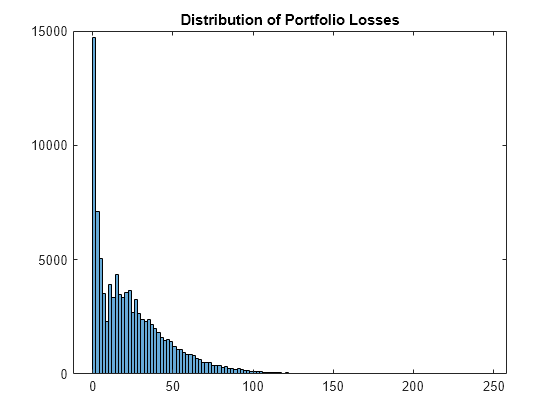creditDefaultCopula
Create creditDefaultCopula object to simulate and analyze
multifactor credit default model
Description
The creditDefaultCopula class simulates portfolio
losses due to counterparty defaults using a multifactor model.
creditDefaultCopula associates each counterparty with a
random variable, called a latent variable, which is mapped to default/non-default
outcomes for each scenario such that defaults occur with probability
PD. In the event of default, a loss for that scenario is
recorded equal to EAD * LGD for the
counterparty. These latent variables are simulated using a multi-factor model, where
systemic credit fluctuations are modeled with a series of risk factors. These
factors can be based on industry sectors (such as financial, aerospace),
geographical regions (such as USA, Eurozone), or any other underlying driver of
credit risk. Each counterparty is assigned a series of weights which determine their
sensitivity to each underlying credit factors.
The inputs to the model describe the credit-sensitive portfolio of exposures:
EAD— Exposure at defaultPD— Probability of defaultLGD— Loss given default (1 − Recovery)Weights— Factor and idiosyncratic model weights
After the creditDefaultCopula object is created (see Create creditDefaultCopula and Properties), use the simulate function to simulate credit defaults using the multifactor
model. The results are stored in the form of a distribution of losses at the
portfolio and counterparty level. Several risk measures at the portfolio level are
calculated, and the risk contributions from individual obligors. The model calculates:
Full simulated distribution of portfolio losses across scenarios
Losses on each counterparty across scenarios
Several risk measures (
VaR,CVaR,EL,Std) with confidence intervalsRisk contributions per counterparty (for
ELandCVaR)
Creation
Description
cdc = creditDefaultCopula(EAD,PD,LGD,Weights)creditDefaultCopula object. The
creditDefaultCopula object has the following properties:
A table with the following variables (each row of the table represents one counterparty):
ID— ID to identify each counterpartyEAD— Exposure at defaultPD— Probability of defaultLGD— Loss given defaultWeights— Factor and idiosyncratic weights for counterparties
Factor correlation matrix, a
NumFactors-by-NumFactorsmatrix that defines the correlation between the risk factors.The value-at-risk level, used when reporting VaR and CVaR.
Portfolio losses, a
NumScenarios-by-1vector of portfolio losses. This property is empty until thesimulatefunction is used.
cdc = creditDefaultCopula(___,Name,Value)cdc =
creditDefaultCopula(EAD,PD,LGD,Weights,'VaRLevel',0.99). You
can specify multiple name-value pairs as optional name-value pair arguments.
Input Arguments
Name-Value Arguments
Properties
Object Functions
simulate | Simulate credit defaults using a creditDefaultCopula
object |
portfolioRisk | Generate portfolio-level risk measurements |
riskContribution | Generate risk contributions for each counterparty in portfolio |
confidenceBands | Confidence interval bands |
getScenarios | Counterparty scenarios |
Examples
References
[1] Crouhy, M., Galai, D., and Mark, R. “A Comparative Analysis of Current Credit Risk Models.” Journal of Banking and Finance. Vol. 24, 2000, pp. 59 – 117.
[2] Gordy, M. “A Comparative Anatomy of Credit Risk Models.” Journal of Banking and Finance. Vol. 24, 2000, pp. 119 – 149.
[3] Gupton, G., Finger, C., and Bhatia, M. “CreditMetrics – Technical Document.” J. P. Morgan, New York, 1997.
[4] Jorion, P. Financial Risk Manager Handbook. 6th Edition. Wiley Finance, 2011.
[5] Löffler, G., and Posch, P. Credit Risk Modeling Using Excel and VBA. Wiley Finance, 2007.
[6] McNeil, A., Frey, R., and Embrechts, P. Quantitative Risk Management: Concepts, Techniques, and Tools. Princeton University Press, 2005.
Version History
Introduced in R2017a
See Also
table | simulate | portfolioRisk | riskContribution | confidenceBands | getScenarios | creditMigrationCopula | nearcorr
